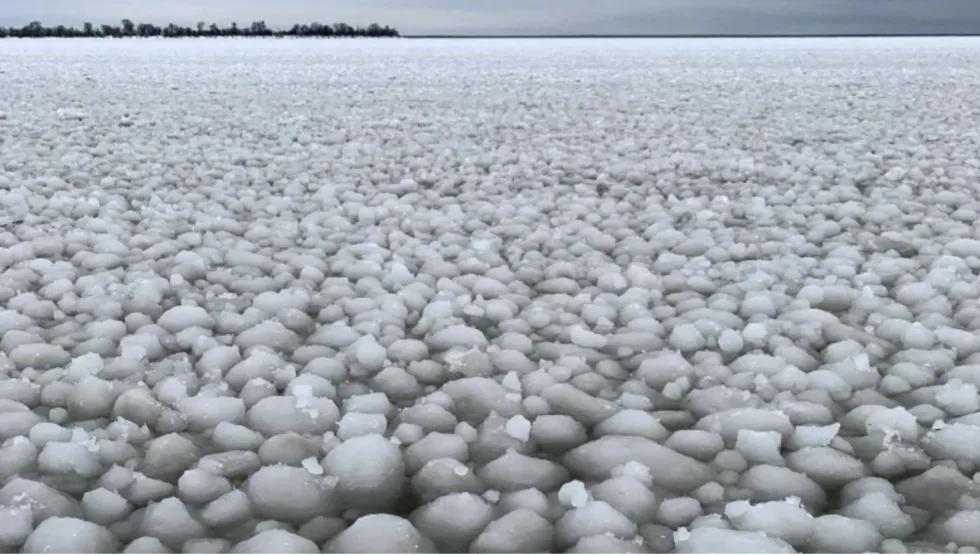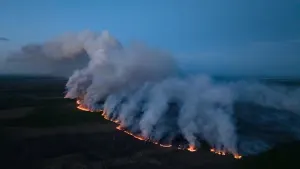
Lake Manitoba shows off rare ice formations
Mother Nature has turned Lake Manitoba into a visual art project that has an ice expert in awe.
What would typically be a flat, frozen surface has been turned into something more resembling pebbles and stones, as far as the eye can see.
In another area, the water has crystallized into geometric lines that look like someone spilled a box of toothpicks or needles on the ground and they froze there.
Glaciologist Jeff Kavanaugh says the phenomena are due to supercooled water — water that remains liquid below its normal freezing point — being moved and rolled by wind as it begins to solidify.

Pebbly ice formations stretch out across Lake Manitoba from the eastern shore near Steep Rock, about 200 kilometres northwest of Winnipeg. (Submitted by Peter Hofbauer via CBC)
The round stone-like shapes are actually known as slush balls — "a very poetic name, I know," he said with a chuckle.
They are the rarer phenomenon of the two — so much so that Kavanaugh, an associate professor in earth and atmospheric sciences at the University of Alberta, has never experienced them in person.
"It's something I would definitely like to see," he told host Marcy Markusa in an interview with CBC's Information Radio on Tuesday.

Peter Hofbauer posted his photos on Instagram, where they have been liked and shared hundreds of times. (Submitted by Peter Hofbauer via CBC)
The ice anomalies were spotted on the weekend by Peter Hofbauer, who owns Steep Rock Kayak and Canoe on the eastern shore of the lake, about 200 kilometres northwest of Winnipeg.
He took photos and posted them on Instagram with the simple question: "Have you ever seen the lake freeze like this?"
The post has been liked and shared hundreds of times, with many people calling the formations beautiful, amazing and fascinating.
"Nature is incredible and so are these pics," another person posted.
Hofbauer told Markusa he was kayaking exactly seven days before he took the photos.
After doing some research about the ice shapes, he found a certain set of conditions had to come together at the right time — rapidly cooling air temperature, open water close to being frozen and the right amount of wind.
"The water created these balls of ice and they just accumulated against the shore, and it seemed to just spread out over the lake as far as I could see," he said.

The slush balls are delicate and don't last long when picked up — much like what would happen if you took a weakly compacted snowball and put it in water, says glaciologist Jeff Kavanaugh. (Submitted by Peter Hofbauer via CBC)
According to Kavanaugh, that's exactly right.
There has to be a brief window where the water is open but also cold enough at the surface that these slush balls can form from wave action.
"If it's windy enough to to whip up the water, there can be droplets that pop into the air and freeze and fall back as ice," he said.
"And if there's enough wave action from that wind, instead of forming the pancake ice, those pancakes are broken up, and they roll around in the waves and form these slush balls."
Curious about the underside, Hofbauer went out Monday night and cut out a section to look at the bottom, which was much smoother. But he noted shortly after they were removed from the mass, the balls turned into snow.
"That's why they call it slush balls," said Kavanaugh. "They're very much like if you took a snowball — a weakly compacted snowball … and put it in water. They're pretty delicate."

Kavanaugh said the stick-like formations happen in calm conditions when supercooled water molecules arrange themselves into crystals that tend to grow like needles. (Submitted by Peter Hofbauer via CBC)
As for the stick-like formations, each of which was about eight centimetres long, Hofbauer found those along very thin ice at the shore.
Those are again formed again by supercooled water but with less wave influence, Kavanaugh said.
"In a calm condition, the water molecules can arrange themselves into these crystals and they tend to grow like needles. You'll see this sometimes in puddles on the sidewalk after a rain and then the following cold snap," he said.
Unaware of the less-than-scientific name for the round slush balls, Hofbauer created his own Latin name for the phenomenon: Cryolapidarius maritimus, which he says means "stone formations that are cold from the sea."
"Yup, a much better name than slush balls," Kavanaugh agreed.
This article, written by Darren Bernhardt, was originally published for CBC News on Nov. 23. Contains files from Jim Agapito.









